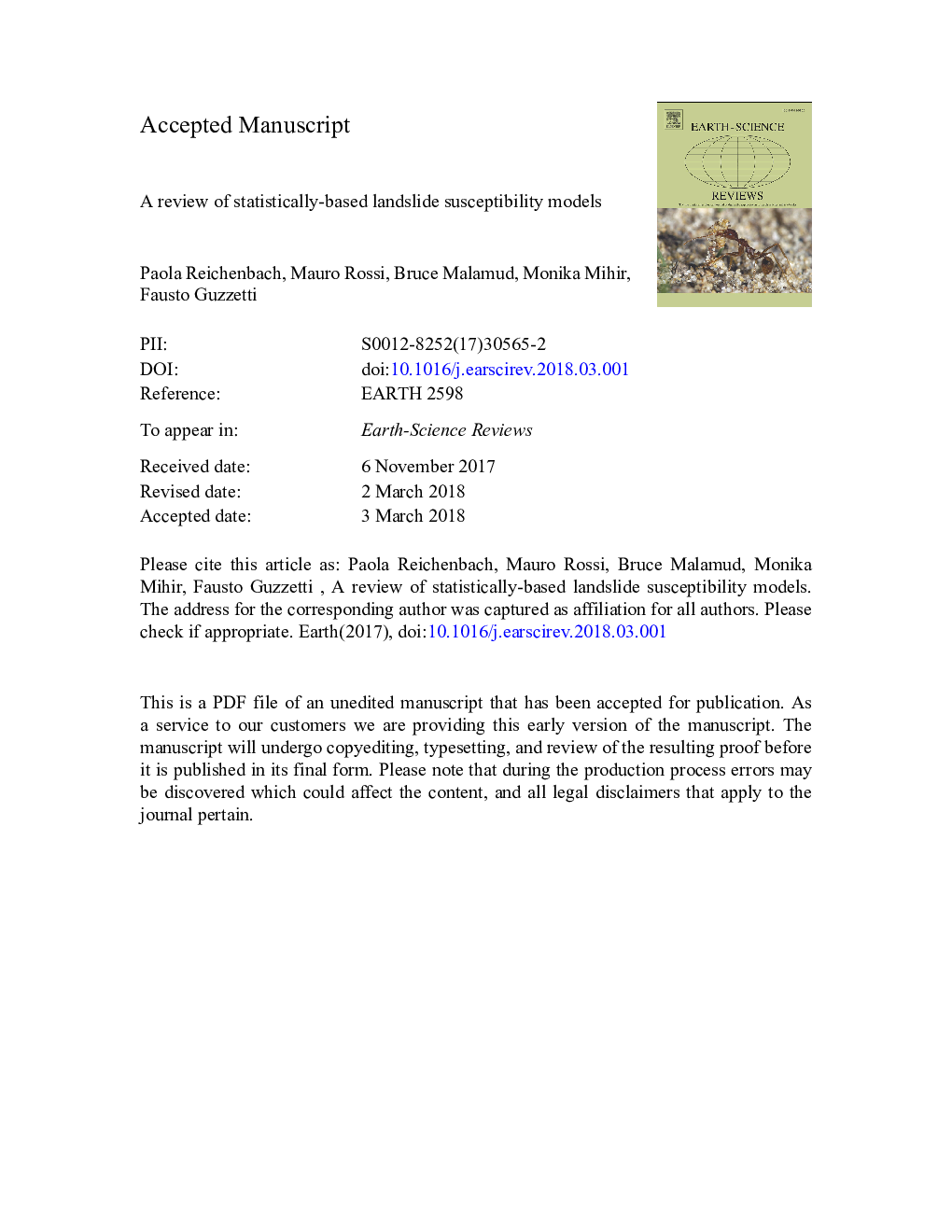| کد مقاله | کد نشریه | سال انتشار | مقاله انگلیسی | نسخه تمام متن |
|---|---|---|---|---|
| 8912952 | 1639922 | 2018 | 125 صفحه PDF | دانلود رایگان |
عنوان انگلیسی مقاله ISI
A review of statistically-based landslide susceptibility models
ترجمه فارسی عنوان
بررسی مدلهای حساس به لغزش لغزش آماری
دانلود مقاله + سفارش ترجمه
دانلود مقاله ISI انگلیسی
رایگان برای ایرانیان
کلمات کلیدی
بررسی ادبیات، رانش زمین، زون حساسیت، مدل آماری،
ترجمه چکیده
در این مقاله، بررسی انتقادی از روش های آماری برای مدل سازی حساسیت به لغزش و ارتباطات مربوط به زمین را بررسی می کنیم. حساسیت به زمین لغزش احتمال زمین لغزش در یک منطقه بسته به شرایط زمین محلی است، تخمین زده شده است؟ زمین لغزش ها احتمالا رخ می دهد. از آنجایی که اولین تلاش برای ارزیابی حساسیت به لغزش در اواسط دهه 1970، صدها مقاله با استفاده از روش ها و روش های مختلف در محیط های مختلف زمین شناسی و آب و هوایی منتشر شده است. در اینجا ما انتقادی از ادبیات ارزیابی حساسیت به لغزش لغزش آماری را با بررسی سیستماتیک و سپس تهیه یک پایگاه داده گسترده از 565 مقالات بررسی مقیاس از سال 1983 تا 2016 را بررسی می کنیم. برای هر مقاله در پایگاه داده ادبیات، 31 دسته / اطلاعات شامل منطقه / محدوده مطالعه، نوع لغزش / نوع لغزش، نوع موجودی و دوره تحت پوشش، مدل آماری مورد استفاده، از جمله انواع متغیر، روش ارزیابی عملکرد مدل / پیش بینی و استراتژی مورد استفاده برای ارزیابی عدم قطعیت مدل. ما تصویرسازی های گرافیکی و بحث های مشترک و تفاوت ها را به عنوان تابع منطقه و زمان ارائه می کنیم که نشان دهنده ناهمگونی قابل توجهی از انواع داده ها و مقیاس های موضوعی، رویکردهای مدل سازی و معیارهای ارزیابی مدل است. ما دریافتیم که طیف وسیعی از انواع داده های موضوعی مورد استفاده برای ارزیابی حساسیت با زمان بسیار تغییر نکرده است و برای تعدادی از مطالعات اهمیت ژئومورفولوژیکی داده های موضوعی مورد استفاده ضعیف است. همچنین ما دریافتیم که شایع ترین روش های آماری برای مدل سازی حساسیت به لغزش، شامل رگرسیون لجستیک، تجزیه و تحلیل شبکه عصبی، پوشش داده، شاخصه و وزن تحلیل شواهد، با توجه به افزایش اولویت نسبت به روش های یادگیری دستگاه در سال های اخیر است. اگرچه تعداد روزافزون مطالعاتی که در سالهای اخیر انجام شده است، عملکرد مدل را با توجه به عملکرد مدل و پیش بینی شده، فقط تعداد کمی از مطالعات، عدم قطعیت مدل را ارزیابی کرده اند. با تایید شاخص کیفیت سطح حساسیت، ما دریافتیم که کیفیت مدل های منتشر شده در طول سالها بهبود یافته است، اما ارزیابی با کیفیت بالا هنوز نادر است. ما در موقعیت های مطالعه حساسیت، مطالعات بسیاری در چین، هند، ایتالیا و ترکیه، و تنها تعداد کمی از آن ها در آفریقا، آمریکای جنوبی و اقیانوسیه، شناخته شده است. بر اساس بررسی های ادبیات قبلی، تجزیه و تحلیل اطلاعات جمع آوری شده در پایگاه داده ادبیات و تجربه شخصی ما در مورد این موضوع، ما توصیه هایی برای آماده سازی، ارزیابی و استفاده از مدل های حساس لغزش و مناطق زون های مرتبط با آن ارائه می دهیم.
موضوعات مرتبط
مهندسی و علوم پایه
علوم زمین و سیارات
زمین شناسی
چکیده انگلیسی
In this paper, we do a critical review of statistical methods for landslide susceptibility modelling and associated terrain zonations. Landslide susceptibility is the likelihood of a landslide occurring in an area depending on local terrain conditions, estimating “where” landslides are likely to occur. Since the first attempts to assess landslide susceptibility in the mid-1970s, hundreds of papers have been published using a variety of approaches and methods in different geological and climatic settings. Here, we critically review the statistically-based landslide susceptibility assessment literature by systematically searching for and then compiling an extensive database of 565 peer-review articles from 1983 to 2016. For each article in the literature database, we noted 31 categories/sub-categories of information including study region/extent, landslide type/number, inventory type and period covered, statistical model used, including variable types, model fit/prediction performance evaluation method, and strategy used to assess the model uncertainty. We present graphical visualisations and discussions of commonalities and differences found as a function of region and time, revealing a significant heterogeneity of thematic data types and scales, modelling approaches, and model evaluation criteria. We found that the range of thematic data types used for susceptibility assessment has not changed significantly with time, and that for a number of studies the geomorphological significance of the thematic data used is poorly justified. We also found that the most common statistical methods for landslide susceptibility modelling include logistic regression, neural network analysis, data-overlay, index-based and weight of evidence analyses, with an increasing preference towards machine learning methods in the recent years. Although an increasing number of studies in recent years have assessed the model performance, in terms of model fit and prediction performance, only a handful of studies have evaluated the model uncertainty. Adopting a Susceptibility Quality Level index, we found that the quality of published models has improved over the years, but top-quality assessments remain rare. We identified a clear geographical bias in susceptibility study locations, with many studies in China, India, Italy and Turkey, and only a few in Africa, South America and Oceania. Based on previous literature reviews, the analysis of the information collected in the literature database, and our own experience on the subject, we provide recommendations for the preparation, evaluation, and use of landslide susceptibility models and associated terrain zonations.
ناشر
Database: Elsevier - ScienceDirect (ساینس دایرکت)
Journal: Earth-Science Reviews - Volume 180, May 2018, Pages 60-91
Journal: Earth-Science Reviews - Volume 180, May 2018, Pages 60-91
نویسندگان
Paola Reichenbach, Mauro Rossi, Bruce D. Malamud, Monika Mihir, Fausto Guzzetti,
